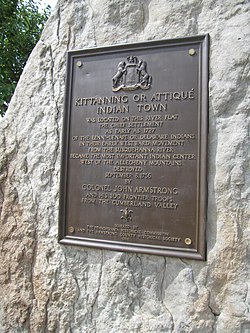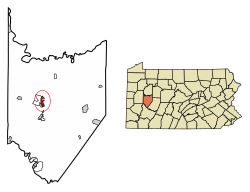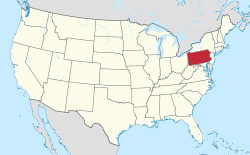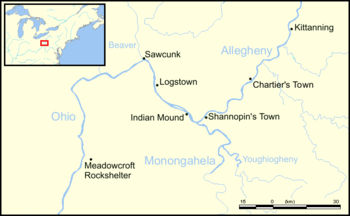Kittanning Village
Kit-Han-Nee | |
|---|---|
Historic Native American village | |
 Plaque at the site of Kittanning Village | |
| Etymology: Unami: kithanink kit- 'big' + hane 'mountain river' + -ink (suffix used in place names). "The main river"[1]: 356 | |
 Location of Kittanning Village in Armstrong County, Pennsylvania | |
 Location of Pennsylvania in the United States | |
| Coordinates: 40°49′12″N 79°31′17″W / 40.820085°N 79.521398°W | |
| State | Pennsylvania |
| Present-day Community | Kittanning, Pennsylvania |
| Founded | 1724-1725 |
| Demolished | 8 September 1756 |
| Population | |
| • Estimate (1754) | 300−400[2]: 46 [3]: 9 |

Kittanning (Lenape Kithanink; pronounced [kitˈhaːniŋ]) was an 18th-century Native American village in the Ohio Country, located on the Allegheny River at present-day Kittanning, Pennsylvania. The village was at the western terminus of the Kittanning Path, an Indian trail that provided a route across the Alleghenies between the Ohio and Susquehanna river basins.[1]: 183
Together with Logstown, Pickawillany, Sandusky, and Lower Shawneetown, Kittanning was one of several large multiethnic and autonomous "Indian republics" made up of a variety of smaller disparate social groups: village fragments, extended families, or individuals, often survivors of epidemics and refugees from conflicts with other Native Americans or with Europeans.[4]
Kittanning served as a staging area for Delaware and Shawnee raids on British colonial settlements during the French and Indian War, until Pennsylvania provincial troops under the command of Colonel John Armstrong destroyed the village on 8 September 1756.
- ^ a b Charles Augustus Hanna, The Wilderness Trail: Or, The Ventures and Adventures of the Pennsylvania Traders on the Allegheny Path, Volume 1, Putnam's sons, 1911
- ^ Grimes, Richard S. The Western Delaware Indian Nation, 1730–1795: Warriors and Diplomats. Lehigh University Press, 2017.
- ^ Cite error: The named reference
Barrwas invoked but never defined (see the help page). - ^ Richard White, The Middle Ground: Indians, Empires, and Republics in the Great Lakes Region, 1650–1815 Cambridge studies in North American Indian history, Cambridge University Press, 1991. ISBN 1139495682